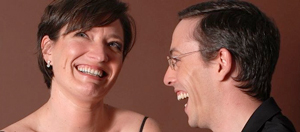by Daniel Hautzinger

When they first encountered each other back in 1990, they would have never predicted this future. “The first time we played together, it was a complete disaster. We vowed we would never play together again,” said Magalhães in a Skype call across an ocean and a hemisphere. “Luis had training that was opposite from mine,” Schumann said. “In the beginning, we couldn’t match at all. But through the years, my playing actually changed: I picked up some of the things that I admired in his playing, and vice versa.”
Now the duo is so attuned to each other that when, in a recent concert, “Luis deliberately played before me on the last chord, I almost fell off my chair,” Schumann said. “We have ensemble because we’ve been playing together for such a long time, and I do believe because we are married. You feel things by instinct after a while,” she added. But much of their precision comes from intense practice. “60-70% of our time is spent on that exactness, because we are playing the same instrument. In an ensemble with different instruments, there are a lot of liberties one can take with attack and precision. To hear two pianos not synchronized is the most disgusting thing,” Magalhães said.
Playing in a piano duo involves many such idiosyncrasies. “The biggest challenge is to play on the same instrument that has a very similar color,” Magalhães said. How to spice up this potential dullness? “I think instead of trying to make ourselves sound like one piano, we very happily sound like two, because we are two individuals, and we perform in that way as well.”
With a pair of hulking instruments between the performers, communication can be difficult. “On stage, all you can see is the other person’s eyebrows and the eyes. You have to go with whatever signals they can give you,” Schumann said. Luckily, “she’s expressive with her eyebrows,” Magalhães added.
A two piano concert can be overwhelming “because, with bad acoustics, it becomes percussion,” Magalhães said. Frederic Rzewski’s Winnsboro Cotton Mill Blues, which TwoPianists will include on an upcoming recording of duo music by American composers, takes advantage of this feature, by asking the pianists to pound the keys with their fists and forearms. “It’s difficult to pull off with an audience, but every time the reaction is just ‘wow.’ We had a couple of concerts where you can hear people adjusting their hearing aids at the beginning of the piece though,” Schumann said. The forthcoming album will also include John Adams’ Hallelujah Junction (“Phenomenal piece, absolutely unbelievable,” Schumann said) and Samuel Barber’s Souvenirs, both of which they will perform in Cleveland.
Finally, there’s the problem of finding duo repertoire. “We prefer not to do transcriptions, but there are so few works originally written for two pianos. I did my dissertation on it and up until the beginning of the 20th century, there were only twenty-two works written for this formation,” Schumann said. There are gems, even if they are arrangements, like Max Reger and Josef Rheinberger’s arrangement of Bach’s beloved Goldberg Variations, originally for solo keyboard. The work, which TwoPianists have recorded and will play in Cleveland, is “a Baroque piece arranged and re-arranged for modern tastes through the eyes and style of Rheinberger and Reger in the 20th century,” Magalhães said.
No matter what the repertoire, “You have to do whatever feels right to you,” Schumann said. TwoPianists certainly seem to follow that advice, be it in starting a record label or playing together. When they perform, Schumann said, “it’s not planned, very inspirational, of the moment, and it’s so much fun.”
Published on ClevelandClassical.com January 20, 2014
Click here for a printable version of this article.

